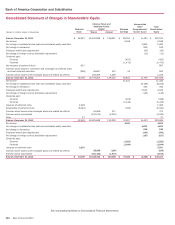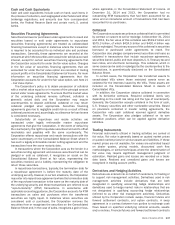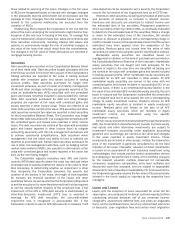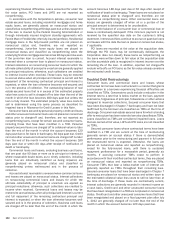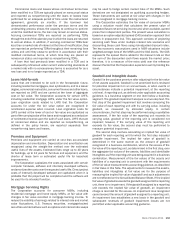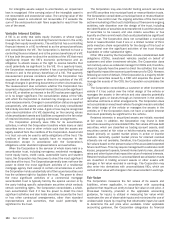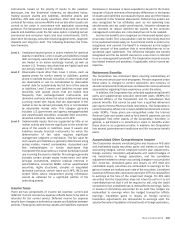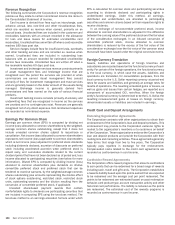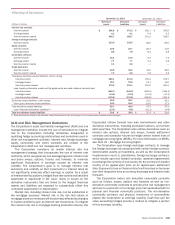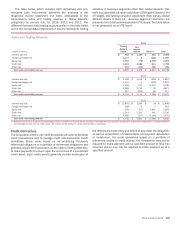Bank of America 2014 Annual Report Download - page 155
Download and view the complete annual report
Please find page 155 of the 2014 Bank of America annual report below. You can navigate through the pages in the report by either clicking on the pages listed below, or by using the keyword search tool below to find specific information within the annual report.Bank of America 2014 153
Commercial loans and leases whose contractual terms have
been modified in a TDR are typically placed on nonaccrual status
and reported as nonperforming until the loans or leases have
performed for an adequate period of time under the restructured
agreement, generally six months. If the borrower had
demonstrated performance under the previous terms and the
underwriting process shows the capacity to continue to perform
under the modified terms, the loan may remain on accrual status.
Accruing commercial TDRs are reported as performing TDRs
through the end of the calendar year in which the loans are returned
to accrual status. In addition, if accruing commercial TDRs bear
less than a market rate of interest at the time of modification, they
are reported as performing TDRs throughout their remaining lives
unless and until they cease to perform in accordance with their
modified contractual terms, at which time they are placed on
nonaccrual status and reported as nonperforming TDRs.
A loan that had previously been modified in a TDR and is
subsequently refinanced under current underwriting standards at
a market rate with no concessionary terms is accounted for as a
new loan and is no longer reported as a TDR.
Loans Held-for-sale
Loans that are intended to be sold in the foreseeable future,
including residential mortgages, loan syndications, and to a lesser
degree, commercial real estate, consumer finance and other loans,
are reported as LHFS and are carried at the lower of aggregate
cost or fair value. The Corporation accounts for certain LHFS,
including residential mortgage LHFS, under the fair value option.
Loan origination costs related to LHFS that the Corporation
accounts for under the fair value option are recognized in
noninterest expense when incurred. Loan origination costs for
LHFS carried at the lower of cost or fair value are capitalized as
part of the carrying value of the loans and recognized as a reduction
of noninterest income upon the sale of such loans. LHFS that are
on nonaccrual status and are reported as nonperforming, as
defined in the policy herein, are reported separately from
nonperforming loans and leases.
Premises and Equipment
Premises and equipment are carried at cost less accumulated
depreciation and amortization. Depreciation and amortization are
recognized using the straight-line method over the estimated
useful lives of the assets. Estimated lives range up to 40 years
for buildings, up to 12 years for furniture and equipment, and the
shorter of lease term or estimated useful life for leasehold
improvements.
The Corporation capitalizes the costs associated with certain
computer hardware, software and internally developed software,
and amortizes the costs over the expected useful life. Direct project
costs of internally developed software are capitalized when it is
probable that the project will be completed and the software will
be used for its intended function.
Mortgage Servicing Rights
The Corporation accounts for consumer MSRs, including
residential mortgage and home equity MSRs, at fair value with
changes in fair value recorded in mortgage banking income. To
reduce the volatility of earnings related to interest rate and market
value fluctuations, U.S. Treasury securities, mortgage-backed
securities and derivatives such as options and interest rate swaps
may be used to hedge certain market risks of the MSRs. Such
derivatives are not designated as qualifying accounting hedges.
These instruments are carried at fair value with changes in fair
value recognized in mortgage banking income.
The Corporation estimates the fair value of consumer MSRs
using a valuation model that calculates the present value of
estimated future net servicing income and, when available, quoted
prices from independent parties. The present value calculation is
based on an option-adjusted spread (OAS) valuation approach that
factors in prepayment risk. This approach consists of projecting
servicing cash flows under multiple interest rate scenarios and
discounting these cash flows using risk-adjusted discount rates.
The key economic assumptions used in MSR valuations include
weighted-average lives of the MSRs and the OAS levels. The OAS
represents the spread that is added to the discount rate so that
the sum of the discounted cash flows equals the market price;
therefore, it is a measure of the extra yield over the reference
discount factor that the Corporation expects to earn by holding the
asset.
Goodwill and Intangible Assets
Goodwill is the purchase premium after adjusting for the fair value
of net assets acquired. Goodwill is not amortized but is reviewed
for potential impairment on an annual basis, or when events or
circumstances indicate a potential impairment, at the reporting
unit level. A reporting unit, as defined under applicable accounting
guidance, is a business segment or one level below a business
segment. The goodwill impairment analysis is a two-step test. The
first step of the goodwill impairment test involves comparing the
fair value of each reporting unit with its carrying value, including
goodwill, as measured by allocated equity. In certain
circumstances, the first step may be performed using a qualitative
assessment. If the fair value of the reporting unit exceeds its
carrying value, goodwill of the reporting unit is considered not
impaired; however, if the carrying value of the reporting unit
exceeds its fair value, the second step must be performed to
measure potential impairment.
The second step involves calculating an implied fair value of
goodwill for each reporting unit for which the first step indicated
possible impairment. The implied fair value of goodwill is
determined in the same manner as the amount of goodwill
recognized in a business combination, which is the excess of the
fair value of the reporting unit, as determined in the first step, over
the aggregate fair values of the assets, liabilities and identifiable
intangibles as if the reporting unit was being acquired in a business
combination. Measurement of the fair values of the assets and
liabilities of a reporting unit is consistent with the requirements
of the fair value measurements accounting guidance, as described
in Fair Value in this Note. The adjustments to measure the assets,
liabilities and intangibles at fair value are for the purpose of
measuring the implied fair value of goodwill and such adjustments
are not reflected on the Consolidated Balance Sheet. If the implied
fair value of goodwill exceeds the goodwill assigned to the reporting
unit, there is no impairment. If the goodwill assigned to a reporting
unit exceeds the implied fair value of goodwill, an impairment
charge is recorded for the excess. An impairment loss recognized
cannot exceed the amount of goodwill assigned to a reporting unit.
An impairment loss establishes a new basis in the goodwill and
subsequent reversals of goodwill impairment losses are not
permitted under applicable accounting guidance.



